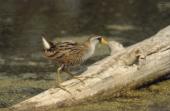
Rails and coots are members of the family Rallidae (order Gruiformes), which are found in the wetlands of all the continents except Antarctica. There are approximately 143 species in the world. They are small to medium-sized omnivorous birds with large feet, short tails, and small wings; many species have lost the ability to fly. Nine species occur in North America; four are known in Saskatchewan. All of these species are migratory.
The most familiar of these birds is the American coot (Fulica americana). This plump grey bird with a white shield on the forehead is very aggressive, and is frequently seen chasing any other water bird which approaches its nesting territory. Coots build their floating nest of vegetation on well-vegetated permanent sloughs and lakes of the south and centre of the province; there are some records from the north.
Rails are heard more often than seen. When disturbed, they are more likely to move off through the vegetation than to fly. Their body shape (“thin as a rail”) helps them move through the bulrushes and cat-tails. The sora (Porzana carolina), a medium-sized rail with a barred body and back, grey face and chest, and black mask, is fairly widespread. Its whinnying call can come from a small slough or the edge of a lake. The Virginia rail (Rallus limicola), with a longer bill and cinnamon chest with barring on the side, is heard “grunting” around the larger marshes of the south and centre. The tiny yellow rail (Coturnicops novaborascensis) is seldom seen, but its clicking call can be heard in the larger marshes of the southern half of the province.
Diane Secoy